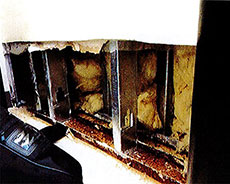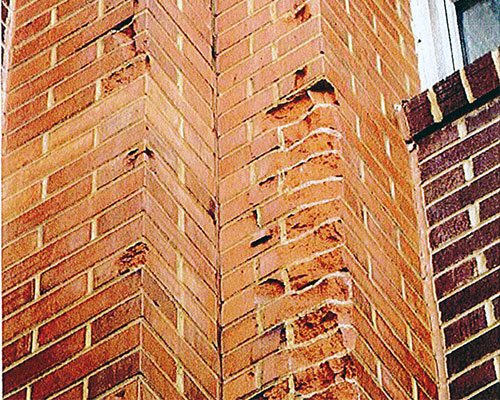The study included photographs of exterior and interior building damage.

The state found corrosion on wall studs within the narcotics office.
The 16-year-old Haverhill Police Station requires substantial indoor and outdoor repairs because of “chronic moisture infiltration” and “visible microbial growth,” according to a state Department of Health (DPH) report released last week.
Dr. Michael A. Feeney, director, Indoor Air Quality Program at DPH, released the department’s findings Aug. 21 after an on-site examination last March 20. Haverhill Police Officer Scott Ziminski requested the assessment after expressing concerns about water damage.
“Water-damaged ceiling tiles and building materials were found in numerous rooms throughout the HPD. The ceiling tiles should be replaced after a water leak is discovered and repaired. It appears that there are multiple causes of water damage in the HPD: historic roof leaks, ice dams during January/February of 2015 and window frames without flashing. It was reported that a new roof was recently installed prior to the assessment. No other repair work of flashing or window leaks has occurred,” according to the report.
Findings also suggested the building does not have energy efficient windows and has inadequate insulation in exterior walls. The report noted temperature differences in the narcotics room’s “exterior walls were five to more than ten degrees colder than adjacent walls.”
“This repeated exposure to moisture/condensation can lead to mold growth and corrosion, as seen in the narcotics office closet wall studs.”
DPH recommends the city consult with a building specialist to identify specific sources of moisture and produce a detailed plan to mitigate these sources, remove “water-damaged/mold-colonized building materials,” replace water-damaged ceiling tiles and building materials, operate ventilation continuously during occupied hours, seal gaps and spaces, relocate or consider reducing materials stored in office areas to allow for more thorough cleaning, change ventilation filters more often, avoid piling snow against the building in winter and clean carpeting annually or semi-annually in soiled high traffic areas.
“Areas of particular concern would be building/window flashing, brick and mortar issues (cracking, spalling, missing mortar, etc.), weatherization (caulking, insulation, windows, vapor barriers, etc.), weep hole system and internal condensation sources,” the study reported. Cost estimates were not included.
On the plus side, the report said there were no measurable levels of carbon monoxide, interior temperatures were normal and carbon dioxide levels are below levels of concern.
Copies of the report were provided to Ziminski, Police Chief Alan R. DeNaro, Board of Health Chairman Carl F. Rosenbloom, state Bureau of Environmental Health Acting Director Jan Sullivan, Rep. Brian S. Dempsey and Sen. Kathleen O’Connor Ives.
A new roof was installed at the building this year and city councilors recently approved spending to improve the station’s sprinkler system. The building was constructed in 1999 at an initial cost of $6.6 million. Donham & Sweeney, Boston, served as architect; Palladium Construction Corp., Wakefield, was general contractor and DM Berg Consultants, Needham, performed engineering services. A subcontractor declared bankruptcy during construction, delaying the building’s opening a year and after concerns about leaking roofs and poor workmanship.


The builder should be sued. 16 years old? The roof leaked in under 10 years.
He went BK and out of business.
The roof has been leaking FROM THE START and THE CITY KNEW ABOUT IT. See this story :
http://valleypatriot.com/6-6m-haverhill-police-station-fraud-unhealthy-work-conditions/
All along city leaders knew about the issues and ignored them. The fire suppression sprinkler system was recalled back in 2001 and nobody did anything about it until this year.
http://valleypatriot.com/haverhill-police-station-sprinklers-recalled-city-officials-never-replaced-them/
So this is the leadership your city has had and still has !! These are the same folks that will be maintaining the new Hunking school. Be carefull who you vote for ! Good luck !!